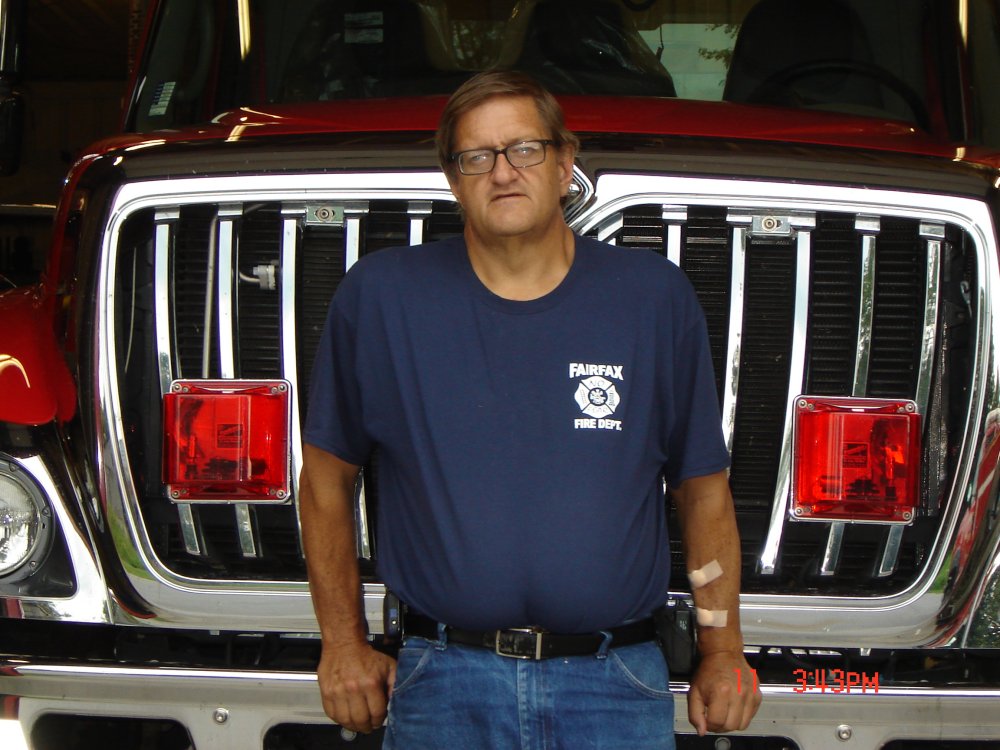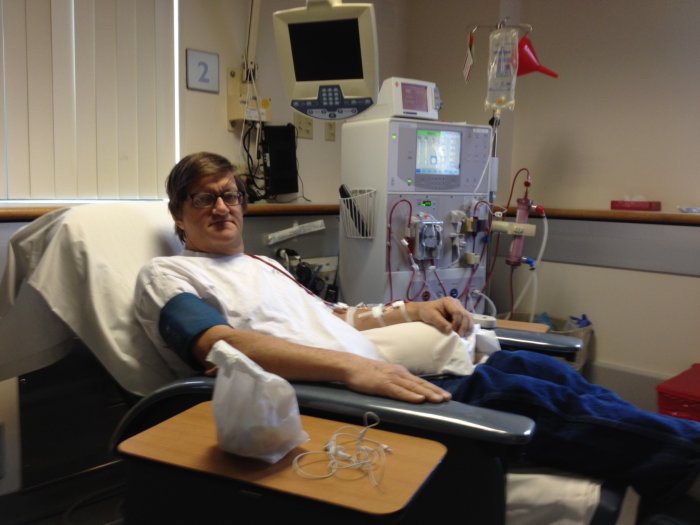
THE LONG WAIT
CAIN ABLE AND READY FOR KIDNEY TRANSPLANTS

THIS ARTICLE APPEARED IN THE FRIDAY, AUGUST 31, 2012 EDITION OF
THE ST. ALBANS MESSENGER
By LISA M. BOUCHER
Messenger Correspondent
FAIRFAX - Mike Cain is a busy guy. It's not uncommon to see him walking everywhere he goes in town.
He's a custodian at Bellows Free Academy, Fairfax, president of the Fairfax Historical Society, an active volunteer firefighter, and an avid fan of auto racing. He also receives hemodialysis three times a week to keep him alive, while he waits for a donor kidney.
Cain, 51, had both kidney removed in March of this year, due to complications from Polycystic Kidney Disease (PKD). He has been on dialysis since. He was diagnosed in 2006 when it was discovered that he had an elevated creatinine level. Creatinine (cree-at-in-in) is a waste product normally found in trace amounts in the blood and is excreted daily by the kidneys. Increased quantities are indicative of renal disease.
He was referred to a physician at Fletcher Allen Health Care (FAHC) and underwent further diagnostic tests. "The tech couldn’t find the kidneys on the ultrasound, because of all the cysts,” Cain said.
Polycystic Kidney Disease is a genetic disorder that can run in families. It causes small clusters of benign fluid filled sacs (cysts) to develop on the kidneys. The severity of PKD can vary widely, but common complications of the disorder are hypertension and kidney failure.
The size of a normal kidney is a little less than a pound an infected kidney can weigh as much as 20 or more pounds.
By March of 2008, Cain's creatinine level was 3 (normal values range from 0.7 to 1.3 for men) and his physician recommended asking his family members for a kidney, stating he would need one in about three years. At the time, Cain weighed about 310 pounds; he needed to be a maximum of 265 pounds per transplant requirements.
"I gave up two girlfriends," he deadpanned. "Little Debbie and Dolly Madison, within three months, I was down to 279 pounds." Cain is a tall man and is currently at the weight he needs to be at.
He said he looked around the inpatient hemodialysis unit at FAHC and didn't like what he saw, inding the experience a little surreal. According to Cain, the small ward of approximately a half-dozen beds appeared much larger to him and the dialysis machines hooked up to frail looking, ill individuals made him feel determined it was a place he didn't want to be. He knew he'd have to be in as good health as possible for a transplant.
"I took a lot of tests and passed those," he said.
In 2010, he had an ateriovenous fistula placed in his arm, although he continued to refuse dialysis (this is a surgical attachment of an artery to a vein to create a larger vein by pumping blood directly into it. The vein is then accessed during dialysis. Cain said he "made himself do things" even though he could feel his energy; level-beginning to flag some and he continued on about his daily routine.
However, in another couple of years, things changed to the point that Cain couldn't ignore them any longer. "By mid-February (2012), I didn't feel good," he said. "I felt bloated and called in sick."
Cain said by March 1, he was having difficulty breathing and finally decided to see his doctor. It was discovered that a cyst had ruptured and he had been hemorrhaging. The decision was made to remove both kidneys because his surgeon felt this was going to continue to happen and repeated blood transfusions makes it more difficult to. receive a successful organ match.
Cain has been active on the National Organ Donor waiting list for three years. He didn't approach his family or friends, because he doesn't feel right about asking someone to donate a "kidney. He's also pensive ,when discussing being on the National Organ Donation list.
"Someone has to die ... " his voice trails off.
Being on the list isn't a guarantee an organ match will become available, as Cain stated, someone has to die and that someone not only has to be an organ donor, but the family also has to consent.
Wait times for transplants vary and not everyone who needs a transplant will get one. Because of a shortage of suitable organs for donation, barely more than 50 percent of people on the list will receive an organ within five year.

Although he didn't speculate on his wait time, he did state that he had made peace with the FAHC inpatient dialysis unit, where he went for treatment while in the hospital and then for about a month after until he got his strength back then transferred to the outpatient unit in St. Albans "It was one place I didn't want to go," he said. "But when I was done, I hated to leave."
For the time being Cain has settled into' a new "normal," he still does the things he has always done and goes to dialysis three days a week and spends the better part of the day there. He works a modified schedule and continues his other activities as his energy allows. He admits to sometimes feeling tired after receiving a treatment, but says he's mostly fine.
Cain feels grateful that he has
good health insurance and has been treated well by his employer. He
said, "When all is said an done, I'm writing a letter to the school
board and the teacher's union, thanking them."
After I read the above article in the St. Albans Messenger, I sent Mike a note
and asked him if there were anything he would add or change to the article and
he sent me back the following note:
"Hi Henry!
A couple of things.
First, I am well below the target weight. I needed to be 265 for a transplant. Now I am hovering around the 234 mark.
The doctor asked if I had thought about asking someone for a kidney. Because it is hereditary, someone else in the family may have it, but I don’t believe anyone does. I wasn’t going to ask any family members because they might have it. He didn’t have me ask someone in my family. Just ask around for a kidney. Again, this was something I couldn’t do.
Mid February was when the cyst ruptured. They figured that out at the emergency room in St. Albans. The reason for the shortness of breath was that I lost half my hemoglobin because I was still bleeding.
With the CT scan at NWMC, the spot of blood surrounding the kidney was the size of a grapefruit. Week and a half later at FAHC, it was the size of a football.
I was initially sent to the dialysis unit at FAHC in the summer of 2010. The doctor felt a dip in the fistula vein, and wanted the nurses at the dialysis unit to check it out. I talked about my apprehension about being there, and the nurse told me that the people who were there NEEDED to be there. Unfortunately, in the end, I NEEDED to be there as well.
Mike"
Henry A.
Raymond
vtgrandpa@yahoo.com
August 31, 2012